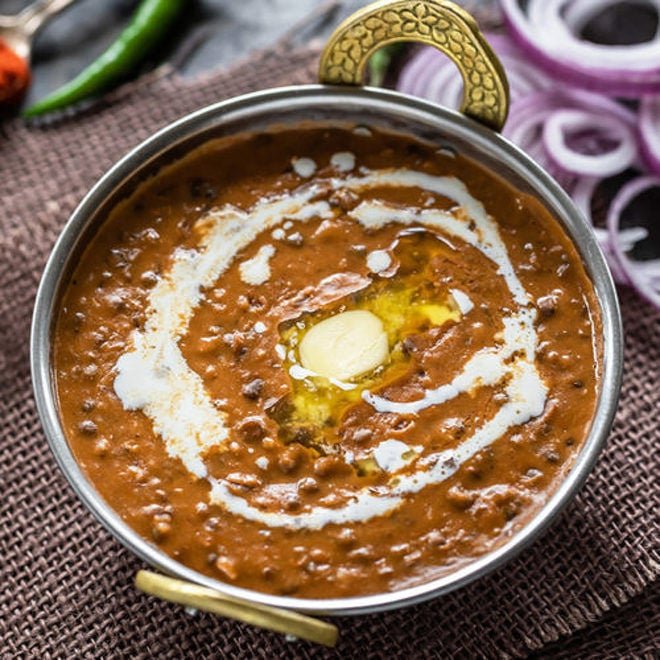Bring the Flavors of the Roadside Dhaba to Your Kitchen With the Dhaba Style Dal Makhni!
Dal Makhani is a traditional Punjabi dish prepared with Indian masalas, healthy fats, and black urad lentils. Vegetarians often comment on how their mothers’ preparation of Dal Makhani during their childhoods helped make their childhoods memorable.
The traditional Dal makhani recipe involves soaking the black urad lentils overnight and cooking them until soft the next day. But that is no longer necessary because we have the pressure cooker to speed up the cooking process.
Kundan Lal Gujaral, the creator of Butter Chicken, invented the popular Dal Makhani recipe. In the 1940s, he changed the face of Indian cuisine by founding the Moti Mahal food chain and introducing Dal Makhani.
He experimented with it while crossing national borders by adding a mixture of tomato puree and cream. His recipe quickly became a massive hit because he was the first Punjabi to do so.
Dhabas or Restaurants on the Indian Highway?
Compared to their modern counterparts, the old ones were somewhat rustic and basic in terms of infrastructure. There were few dedicated parking spaces or valet parking, as modern hotels frequently provide. Instead, there used to be an uncemented driveway in front of where we used to drive in and park the car at one end. A traditional cot or charpai would be waiting for us, and we would sit up and enjoy a home-style fresh meal.
Typically, these establishments serve vegetarian meals that are prepared fresh every morning. For example, the lentils would be simmered in large pots, while the cook would make the base gravies separately. The lentils are allowed to bubble throughout the day, with occasional stirring, to ensure maximum taste and flavor.
The chef would take a ladleful of black lentils that had been lusciously cooked with some salt and water as we placed our order for this dal makhani. The magic now lies in the spices that the chef has combined with the ginger-tomato paste, which will ensure that this dal makhani earns its popularity.
Understanding Punjabi Cooking
Did you know that this recipe contains no onion? That is correct.
There is a widespread misconception that everything goes into Punjabi cooking. For example, many people consider Punjabi dishes rich because they are made with onion-garlic gravies that are generously topped with ghee and butter. Though I agree with the latter because it uses more dairy products, it rarely uses all three onions, ginger, and garlic simultaneously.
Dal Makhani’s Health Benefits
- Dal Makhani is a good option for anyone trying to lose weight or eat healthier.
- It aids in the maintenance of healthy bones and lean muscle mass because it is a good source of vegetarian protein.
- Those concerned about calories can cook with low-fat cream, making the recipe suitable for people with diabetes.
- The folic acid in Urad Dal aids in forming new cells in the body, while pureed tomatoes are highly antioxidant.
- Tomatoes are high in vitamin C, and low-fat milk is low in carbohydrates.
- One cup of milk contains up to 10 grams of carbohydrates.
- Some variations of this recipe include cooking kidney beans, which provide the body with extra magnesium, which is essential for cognitive health and development.
- You get your daily dose of quercetin when you add coriander leaves as a garnish.
- It’s an immune-boosting nutrient, and adding chopped coriander leaves (raw, not cooked) preserves the herb’s Vitamin C content, giving you even more benefits.
What Goes Well With Dal Makhani?
It goes well with tandoori roti or naan. It was created with love, and it shows. Add a teaspoon of ghee just before serving for an extra yum factor. Many don’t have a tandoor, so you can make it on the stovetop or in the instant pot for now.
Suppose you need to plan a menu for a visitor. Serve with raita boondi and jeera rice. Then, add a simple curry, such as aloo baingan or matar paneer, or any Punjabi curry. Finish the meal with gulab jamun, ras malai, or a simple kheer.
Variations
- Making langar dal or langar wali dal is one of the variations that can be made.
- Langar is a gurdwara’s community kitchen that serves free meals, regardless of religion, caste, gender, economic status, or ethnicity.
- The only difference is that the tempering of ghee and cumin seeds with red chili powder is added at the end instead of cream.
Nutrition Info. (per serving)
- 248 CALORIES
- 13g PROTEIN
- 7g FAT
- 33g CARBS
- 11g FIBER
So, what are you waiting for? Dip your rotis and naans in this and enjoy a delicious Punjabi delicacy for your next meal!






